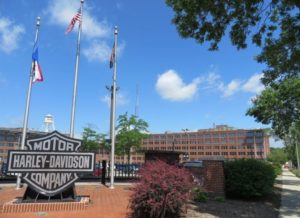Harley-Davidson Inc. plans to make hourly workforce reductions at some of its United States manufacturing plants as it cuts its outlook for motorcycle shipments over the rest of the year.
The company will be cutting approximately 180 jobs from its Menomonee Falls and Kansas City manufacturing operations, Harley spokeswoman Katie Whitmore said in an email.
The Milwaukee-based company now expects to ship 241,000 to 246,000 motorcycles this year. The midpoint of that range represents a drop of more than 18,700 from 2016. It would be the largest decline in shipments since a drop of 80,000 from 2007 to 2008.
Matt Levatich, Harley president and chief executive officer, said the company would continue with “disciplined and aggressive supply management,” reducing the company’s full year shipment guidance from flat to slightly down to a decrease of 6 percent to 8 percent.
Harley is projecting it will ship 39,000 to 44,000 motorcycles in the third quarter, representing a roughly 10 to 20 percent decrease from last year.
“Lower expected shipments means we’ll need to reduce planned production and this has implication for our manufacturing facilities, our people and our financial performance,” Levatich said.
He said the company would have hourly workforce reductions at some of its facilities and would begin notifying employees on Tuesday.
Unions representing workers at both plants issued a statement Tuesday seeking to meet with the company to find alternatives.
“The IAM and USW are disappointed that Harley-Davidson is forced to once again lay off hardworking Americans. We are offering to meet with Harley-Davidson executives to discuss and explore all options for the short and long term health of the company, and most importantly, our members and their welfare,” Robert Martinez Jr., international president of the International Association of Machinists and Aerospace Workers, and Leo Gerard, international president of the United Steelworkers, said in a joint statement.
The decision to cut jobs comes after the company reported a 6.7 percent drop in worldwide retail sales during the second quarter, including a 9.3 percent decline in the United States.
The decline comes against what was also a weak second quarter in 2016. Company executives said the drop was larger than they expected, but they are hopeful expanded distribution and new models will lead to increased international sales in the second half of the year.

“We are not expecting any big improvement in the United States market,” said John Olin, Harley chief financial officer.
Revenue from motorcycles and related products was down 5.6 percent in the quarter to $1.58 billion. Financial services revenue was down 1.5 percent to $188 million. Net income fell 7.7 percent to $258.9 million and earnings declined from $1.55 to $1.48 per diluted share.
Shipments of motorcycles were down 7.2 percent in the quarters as sales declined and customers continued to choose used motorcycles over new ones. Harley has sought to curtail shipments of its 2017 model year to allow dealers to sell surplus 2016 models and apply upward pressure on used motorcycle prices.
“We believe we have the right strategies in place to attract new riders and continue igniting the passion of our current customers, and we will continue to manage our business with focus and discipline as we invest in growing the next generation of Harley-Davidson riders globally,” Whitmore said.
Harley’s quarter wasn’t void of any bright spots. Shipments of touring models, which have the Milwaukee Eight engine and launched last year, were up by 13.4 percent. That segment is the company’s most profitable and an improved product mix helped offset the reduction in volume.
Harley also said when used and new motorcycle sales are combined, sales are up through the first five months of the year. The company has made embracing the used market a part of its long-term strategy, even as it seeks to attract buyers for new motorcycles.
“It’s a great entry point for more price sensitive riders, new riders (and) young adults,” Levatich said.
Olin noted that young adults are 2.5-times more likely to enter the sport on a used motorcycle and the increase in sales is an indication of health for the brand and industry, even if the company doesn’t realize the same revenue off those purchases.
Levatich also briefly touched on two company related stories in recent months. He said the assembly plant the company is building in Thailand, which drew the ire of the company’s unions, would help avoid tariffs in Asia.
He also declined to comment specifically on rumors the company is looking to buy Italian motorcycle maker Ducati, but didn’t say the company wouldn’t make any acquisitions.
“I think the focus is on riders and whatever we need to do as a company to grow the number of riders,” Levatich said. “We don’t feel that other brands necessarily would be key to that strategy, but we’re not going to close any doors.”



